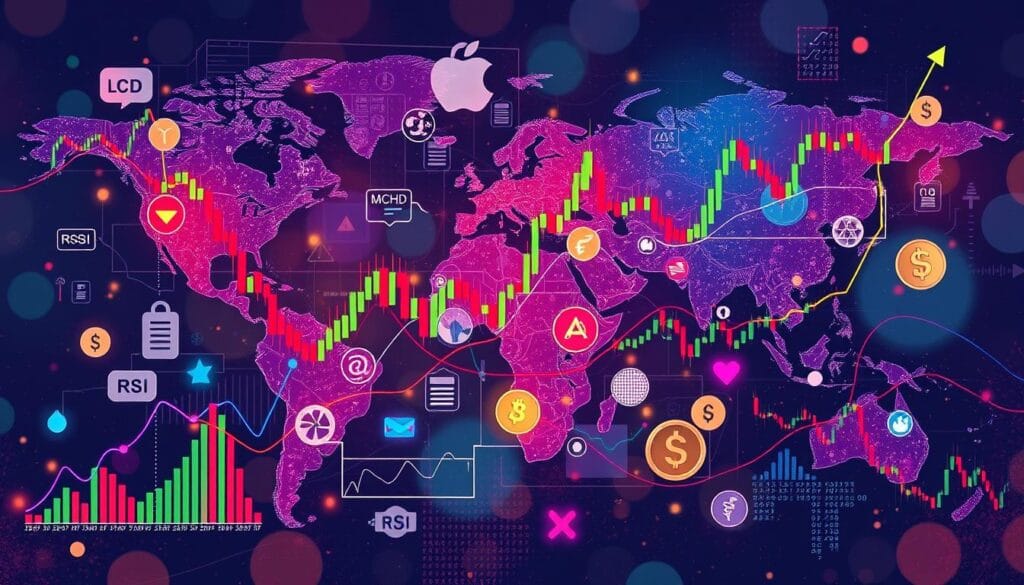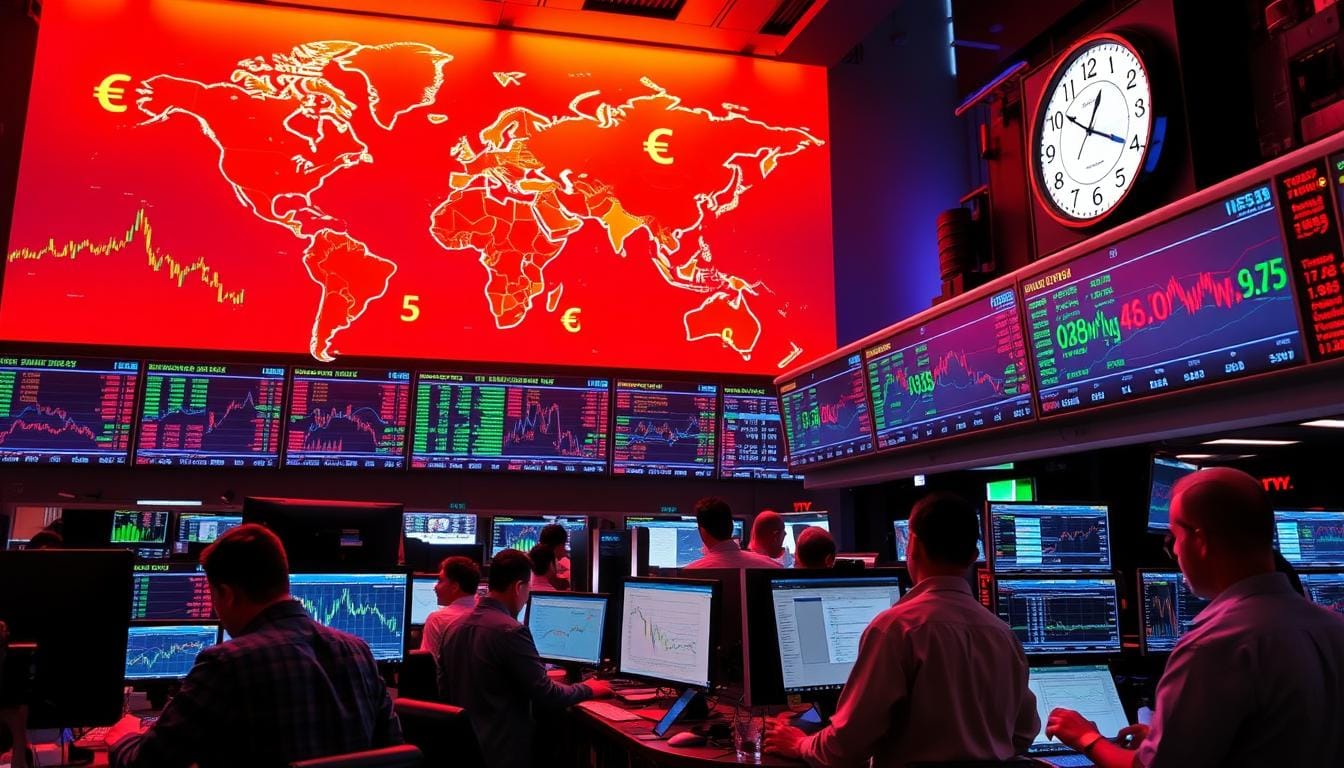השוק הפורקס הוא מקום גלובלי להחלפת מטבעות לאומיים. זה חשוב לשני הסוחרים החדשים והמנוסים. להבנת היסודות של מסחר בפורקס חיונית למי שרוצה להבין את הסביבה הפיננסית הזו.
עם עסקאות שמעלית את 6 טריליון דולר ביומיום, השוק הזה פתוח בכל שעה. זה מלא בהזדמנויות לאלה שמוכנים לקפוץ. מדריך זה מיועד לבניית הבנה יציבה של שווקי מטבע. הוא מסביר את חשיבותם בפיננסים עולמיים ובהשקעות. במהלך הקריאה, תלמד על מה שהופך את השווקים הללו לנזלים ולאימפולסיביים.
מסקנות עיקריות
- השוק הפורקס הוא חיוני למסחר במטבעות לאומיים ברחבי העולם.
- הנפחים היומיים של מסחר בפורקס עולים על 6 טריליון דולר.
- הבנת נזילות השוק חיונית לסוחרים.
- מסחר בפורקס פועל 24 שעות ביממה, ומסתגל לסגנונות מסחר שונים.
- מדריך זה יעזור לך להבין מושגים מרכזיים בשווקי מטבעות.
.
הקדמה למסחר בפורקס
מסחר בפורקס אומר שאתה קונה מטבע אחד ומוכר אחר באותו זמן. זה קורה בשוק גלובלי גדול הנקרא שוק הפורקס. בשוק זה משתמשים בזוגות מטבעות למסחר. אפשר לסחור במטבעות ראשיים, משניים ואקזוטיים.
מהו מסחר בפורקס?
שוק הפורקס הוא השוק הכלכלי הגדול ביותר, עם נפח מסחר יומי של מעל 6 טריליון דולר. אנשים מסחרים בפורקס כדי לנחש על שינויים במחיר ולהגן על עצמם מפלטות ועליות במטבעות. השוק כולל סוחרים פרטיים ובנקים גדולים. מסחר בפורקס עוזר לשמור על יציבות בכלכלות על ידי קביעת שערי חליפין.
חשיבות שווקי מטבע
שווקי המטבע חיוניים לכלכלת העולם. הם מאפשרים לעסקים להחליף כסף בקלות, תורמים למסחר והשקעות בינלאומיים. שינויים בערכי המטבע משפיעים על הכל – מאינפלציה ועד החלטות בנקים מרכזיים. לדעת כיצד זה עובד היא מרכזית להצלחה במסחר בפורקס.
| נושא | תיאור |
|---|---|
| הגדרת מסחר בפורקס | קניית מטבע אחד בעוד מכירת מטבע אחר בשוק גלובלי. |
| שוק הפורקס | השוק הפיננסי הגדול ביותר, המאפשר החלפת מטבעות. |
| החלפת מטבעות | מסחר במטבעות שמשפיע על פעילויות כלכליות גלובליות. |
| חשיבות שוקי המטבע | יציבות במטבעות, גילוי שערי החליפין ונזילות. |
| כלכלות גלובליות | יש להן תלות קרובה בטרנדים בשווקי המטבע ובהחלפות. |
| השפעת מסחר בפורקס | משפיע על אינפלציה, יתר מסחר ומדיניות בנק המרכזי. |
הבנת זוגות מטבע
בשוק הפורקס, היכרות עם זוגות מטבע היא מרכזית. קיימים זוגות מטבע ראשיים, זוגות מטבע משניים, וזוגות אקזוטיים. כל סוג משמש תפקיד באסטרטגיה של סוחר ובניהול סיכונים.
זוגות מטבע ראשיים, משניים, ואקזוטיים
זוגות מטבע ראשיים משלבים את המטבעות הנסחרים ביותר נגד הדולר האמריקני. לדוגמה, EUR/USD ו-USD/JPY הם זוגות ראשיים. הם נמצאים בפופולריות מכיוון שיש להם נזילות גבוהה ופריצות נמוכות.
זוגות מטבע משניים לא כוללים את הדולר האמריקני. הם משלבים מטבעות ראשיים אחרים כמו GBP/AUD או EUR/CHF. זוגות אלו יכולים לעזור בהידור אך יתכן ויהיו להם נזילות נמוכה יותר מזוגות המטבע הראשיים.
זוגות מטבע אקזוטיים משלבים מטבע ראשי עם מטבע משוק נופש, כמו USD/THB. זוגות אלו עשויים להביא רווחים גדולים אך הם יותר סוחרים עקב הולכת המחירים הגבוהה והפריצות הרחבות.
איך זוגות המטבע פועלים
זוג מטבע מציג את הערך של מטבע אחד נגד מטבע אחר. זה מוצג כמחיר רכישה ומכירה. לדוגמה, ב-EUR/USD, היורו הוא הבסיס, מראה כמה דולרים אמריקניים נדרשים כדי לקנות יורו אחד.
ציטוטי פורקס הם חיוניים עבור סוחרים. מחיר הכיבוש הוא מה שסוכן משלם על מטבע הבסיס. מחיר הביקוש הוא מה שהם מוכרים אותו בשביל. הפרש, או ההבדל בין המחירים הללו, חיוני עבור עסקאות.

| סוג זוג מטבעות | דוגמה | נזילות | תנודה |
|---|---|---|---|
| זוגות מטבע ראשיים | EUR/USD | גבוהה | נמוכה עד בינונית |
| זוגות מטבע משניים | GBP/AUD | בינונית | בינונית |
| זוגות מטבע אקזוטיים | USD/THB | נמוכה | גבוהה |
על ידי הבנת מכניקת זוגות מטבע, סוחרים יכולים לקבל החלטות שמתאימות לסגנון המסחר שלהם ולרמת הסיכון שלהם.
סקירת מסחר בפורקס
שוק הפורקס תמיד מפעיל פעילות. הוא כולל מספר רב של שחקנים שונים, ממתחילים ועד מומחים. עם מעל $6 טריליון נסחרים בכל יום, זה ענק ואף פעיל בכל שעות היום והלילה. זה אומר שניתן לסחור בכל שעה ולמצוא המון הזדמנויות.
היקף מסחר בפורקס
מסחר בפורקס מכונה על טווחו הרחב והגישה הקלה שלו. הוא פתוח חמישה ימים בשבוע לסוחרים מכל רחבי העולם. הנה הנקודות העיקריות:
- גודל השוק: זהו השוק הכלכלי הגדול ביותר, המציע המון הזדמנויות למסחר.
- שעות מסחר: בזכות ההתנפצות שעות הזמן, ניתן לסחור ביום או בלילה, ולהתאים את זה לכל אסטרטגיה.
- זוגות מטבע: הם משתנים בהתאם לאירועים עולמיים, חדשות כלכליות, ולרגשות הסוחרים.
שחקנים מרכזיים בשוק
שוק הפורקס מוצק על ידי השחקנים השונים שבו, כל אחד עם תפקידו המיוחד. בואו נסתכל עליהם:
| סוג משתתף | תפקיד |
|---|---|
| בנקי מרכז | הם קובעים מדיניות מוניטרית, מייצבים מטבעות, ושומרים על שליטה באינפלציה. |
| מוסדות פיננסיים | הם מוסיפים נזילות, מבצעים עסקאות עבור לקוחות, וניהלים תיקי השקעות גדולים. |
| חברות | הן מחליפות מטבעות לצורך מסחר גלובלי והשקעות. |
| קרנות סיכון | הן יוזמות להרוויח משינויים בשוק באמצעות שיטות מסחר מסוימות. |
| סוחרים קמעונאיים | אלו הם משקיעים פרטיים שמסחרים דרך סוחרים, המשפיעים על מגמות השוק. |
סוגי אסטרטגיות מסחר בפורקס
הבנת אסטרטגיות מסחר שונות בפורקס היא מרכזית עבור סוחרים. הם רוצים להשיג את המרב משווקי המטבעות. כל אסטרטגיה צריכה את זמנה המשלה, רמות הסיכון וההחזרים האפשריים שלה. הנה כמה שיטות נפוצות:
סקאלפינג
סקאלפינג מתמקדת בעסקאות קצרות טווח כדי לתפוס שינויים קטנים במחיר. סוחרים שעוסקים ב-סקאלפינג בפורקס עושים הרבה עסקאות ביום לרווחים מהירים. גישה זו דורשת מיקוד עצום, קבלת החלטות מהירה וניתוח טכני טוב.
הם צריכים לזהות את הזמנים הטובים ביותר להיכנס ולצאת מעסקאות. עבור סקאלפרים, ניהול העמדות שלהם הוא קריטי מאחר שהדברים מתנהלים במהירות.
מסחר יומי
מסחר יומי אומר קנייה ומכירה של מטבע ביום מסחר. סוחרי יום בפורקס רוצים להרוויח משינויים קטנים במחיר. הם משתמשים ב-טכניקות מסחר יומי וסוגרים את כל העסקאות עד סוף היום. זה חותך את הסיכון של שינויים במחירים בלילה.
שיטה זו דורשת הבנה טובה של מגמות שוק וניתוח תרשימים. סוחרים עושים החלטות בהתבסס על מידע זה כל היום.
סווינג טריידינג
סווינג טריידינג הוא אסטרטגיה בינונית לטווח זמן. המטרה היא לתפוס שינויים במחירים לאורך ימים או שבועות. שיטה זו שונה מאלה של טריידינג קצר טווח.
סוחרי סווינג בפורקס מסתכלים על איתות טכניים וטרנדים בשוק. הם מנסים למצוא מתי טרנדים עשויים להשתנות. בכך, הם יכולים לחשוב יותר על תנועותיהם. זה טוב לאלה שאינם יכולים לצפות בשוק בכל עת.

טכניקות ניתוח שוק הפורקס
בעולם המסחר בפורקס, הבנת טכניקות ניתוח שונות היא מרכזית. סוחרים בדרך כלל משתמשים בשתי שיטות: ניתוח יסודי וניתוח טכני. שתי השיטות נותנות תובנות חשובות להחלטות מסחר.
ניתוח יסודי
ניתוח יסודי בפורקס מביט בתמונה הגדולה של הכלכלה. זה בודק דברים כמו תמות התמ"ג, מספרי עבודה, אינפלציה וריבית. פרטים אלה מראים על בריאות הכלכלה של מדינה, עוזרים לסוחרים לנחש טרנדים בשוק.
ניתוח טכני
ניתוח טכני בשוק ה-forex בודק פעולות מחיר ונפחי מסחר בעבר. סוחרים משתמשים בכלים כמו תרשימי מחיר ו-אינדיקטורים למסחר. המועדפים כוללים ממוצעים נעים ורמות פיבונאצ'י. זיהוי דפוסים עוזר לסוחרים לקבל בחירות טובות יותר.

| סוג ניתוח | נקודות מרכזיות | כלים בשימוש |
|---|---|---|
| ניתוח יסודי | מדדים כלכליים, חדשות שוק | דיווחי חדשות, לוחות כלכליים |
| ניתוח טכני | תרשימי מחירים, מגמות | ממוצעים נעים, רמות פיבונאצ'י, תמיכה/התנגדות |
למידת הניתוחים הללו עוזרת לסוחרים להבין את שוק הפורקס טוב יותר. זה מוביל להחלטות מסחר חכמות.
ניהול סיכונים במסחר בפורקס
ניהול סיכונים הוא מרכזי לקריירה מצליחה במסחר בפורקס. שווקי המסחר עשויים להיות בלתי יציבים ולא צפויים. לדעת כיצד לנהל את ההון שלך בצורה טובה יכול להגן על הכספים שלך ולשפר את תוצאות המסחר שלך. חשוב להבין את השימוש ברמות נטילה, להשתמש בהזמנות עצירת הפסד בצורה חכמה, ולטפל בהון המסחר שלך בזהירות.
הבנת רמות נטילה
הנטילה בפורקס מאפשרת לסוחרים לנהל עמדות גדולות עם פחות כסף. המושג הזה, הידוע גם כמסחר בהשקעה, יכול להגביר את הרווחים הפוטנציאליים. אך, זה סוחף ומורכב. סוחרים צריכים להבין את דרישות ההשקעה ולנהל את הסיכונים שלהם בצורה חכמה. לדעת הכל על נטילה עוזרת לסוחרים להשתמש בה בצורה טובה ולהימנע מפחמימות נפוצות.
הגדרת הזמנות עצירת הפסד
הזמנות עצירת הפסד חיוניות להפחתת הסיכונים במסחר. הן מגדירות מחיר קבוע לסגירה אוטומטית של עמדה, שיכולה להציל סוחרים מתנועות שוק גדולות. השיטה הזו עוזרת לסוחרים להישאר בתוכניות ניהול הסיכונים שלהם, גם כאשר השוק קשה. למידת כיצד עובדת הזמנת עצירת הפסד הופכת את הסוחרים ליותר מאובטחים נגד שינויים פתאומיים בשוק.
ניהול ההון שלך במסחר
ניהול ההון שלך בצורה נכונה הוא מרכזי להצלחה קיימת. חכם לציין תוכנית הקצאת סיכון ברורה ולבחור את הגודל הנכון לכל עסקה. על ידי שימוש באחוז קבוע מההון שלך לכל עסקה, תוכל להפחית את הסיכון ולהתמודד עם התנודות בשוק בצורה יותר טובה. ניהול טוב שומר על חשבון הפורקס שלך בטוח ועוזר למנוע קריאות להפרעה, מה שמביא לאסטרטגיה למסחר מאוזנת ובריאה. הגישה הזו המקופדת מאפשרת לסוחרים לסבול הפסדים מבלי לסכן את כל הכספים שלהם למסחר.
מסקנה
סיכום זה למסחר בפורקס כיסה את היסודות שצריך להתחיל לסחור במטבעות. חשוב להבין את הליבה של מסחר בפורקס כדי לבנות על נושאים מורכבים יותר. ביקשנו איך זוגות המטבעות פועלים, כולל הזוגות המרכזיים, המשניים והאקזוטיים.
דיברנו גם על אסטרטגיות מסחר שונות כמו סקאלפינג, מסחר יומי ומסחר סווינג. כל אחת מתאימה לסוגים שונים של סוחרים. בנוסף, המדריך כיסה שיטות ניתוח חיוניות וטכניות כדי לעזור לך לבצע עסקאות חכמות.
נקודה נוספת קריטית הייתה ניהול הסיכונים בצורה חכמה. על ידי הבנת השימוש ברמות אשראי, בשימוש בהוראות עצירת הפסדים, ובניהול הכספים שלך בצורה יעילה, תוכל להגביל את ההפסדים. המסר המרכזי הוא להמשיך ללמוד ולהתאים בעולם הפורקס.










